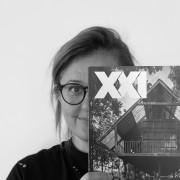The Dialogue Between Space, Material, and Interaction
Katja Wickert’s art questions the relationship between material and object, inviting the audience into this dialogue. Drawing inspiration from everyday life and nature, she explores the meanings of materials through an experimental approach. In this interview, we discuss her artistic process, her connection with materials, and how audience interaction adds new dimensions to her work.
Ferhan Yalçın: The relationship you establish between the material and the object, and also the meanings you attribute to the object, are truly striking. Do you create these unseen connections by drawing inspiration from everyday life and nature? If so, what are the networks in nature and daily life that influence you the most?
Katja Wickert: The basis of my artistic work is my daily life – impressions, experiences, sensations, perceptions in nature, with people in my social environment. I cannot say that it is something specific that particularly influences me, its everything that comes into my life.
FY: Your work often explores the dialogue between the artist, materials, and the audience. How do the relationships you conceptualize transform when they interact with those who experience it?
Given that your works invite viewers to draw their own meanings, how do you see the balance between your personal narrative as an artist and the interpretations of your audience?
KW: First and foremost is the dialog between me as an artist and the material.
Only at the very end, in the presentation, does the interaction with the audience come into play. My original relationship, which has developed in the process with the works, usually remains. It is the basis of the work that is finally released into the world. Through the interaction with the audience, sometimes my works receive confirmation and is also perceived by the audience in a way I experienced it. But it also might be that new levels open up that I wasn´t aware of before. Whether I share them is not important, what is important is that the audience finds something that resonates.
At this point, I would like to mention another level of relationship / interaction between the works and the environment / the space in which the works are shown. An example - last year I showed the newspaper project “God and the World” in a large church in Cologne. The special atmosphere in the church opened up a dialog, a work-space interaction, and brought an even stronger experience of the works for the audience
FY: The materials you use seem to carry significant symbolic weight, yet they also come with their own production challenges. What difficulties have you faced during this process, and how these challenges shaped your understanding of the materials?
KW: Sometimes the choice of materials I work with is an aesthetic, haptic or simply curious decision. Sometimes there is also a content-related, symbolic component that interests me, for example ash, earth or wax. It can also be natural materials such as spruce cones and -needles, leaves or feathers. Used materials from the industrial sector, which already have a history, or discarded materials are also included. This is followed by a mostly playful, experimental exploration of the material and its possibilities. The content-related discussion develops during the work process, unless I have chosen the material with the focus on a specific theme.
My working method is fundamentally experimental and does not follow predetermined rules or techniques. Over the years, I have gained my own experience with materials and this background flows into the treatment and processing. It is important to me to keep trying out, discovering and developing new ways of working with the materials. This freedom is what interests and motivates me about creating art, alongside the opportunity to express my experience and perception of the world.
Related Content:
-

Garden for the Eyes
-

Banánka
-

Taller Estudio Daniela Riquelme
-

15 Years of DesignTO: Toronto’s Festival of Joy, Justice, and Sustainability
-

Modern Guru and the Path to Artificial Happiness by ENESS Continues its Global Odyssey
-

Big Top: The Circus Canteen
-

Tarq Gallery
-

Sister Sylvester and Deniz Tortum's "Shadowtime" Poses a Virtual Reality Check at SXSW
 12.03.2025
12.03.2025



































